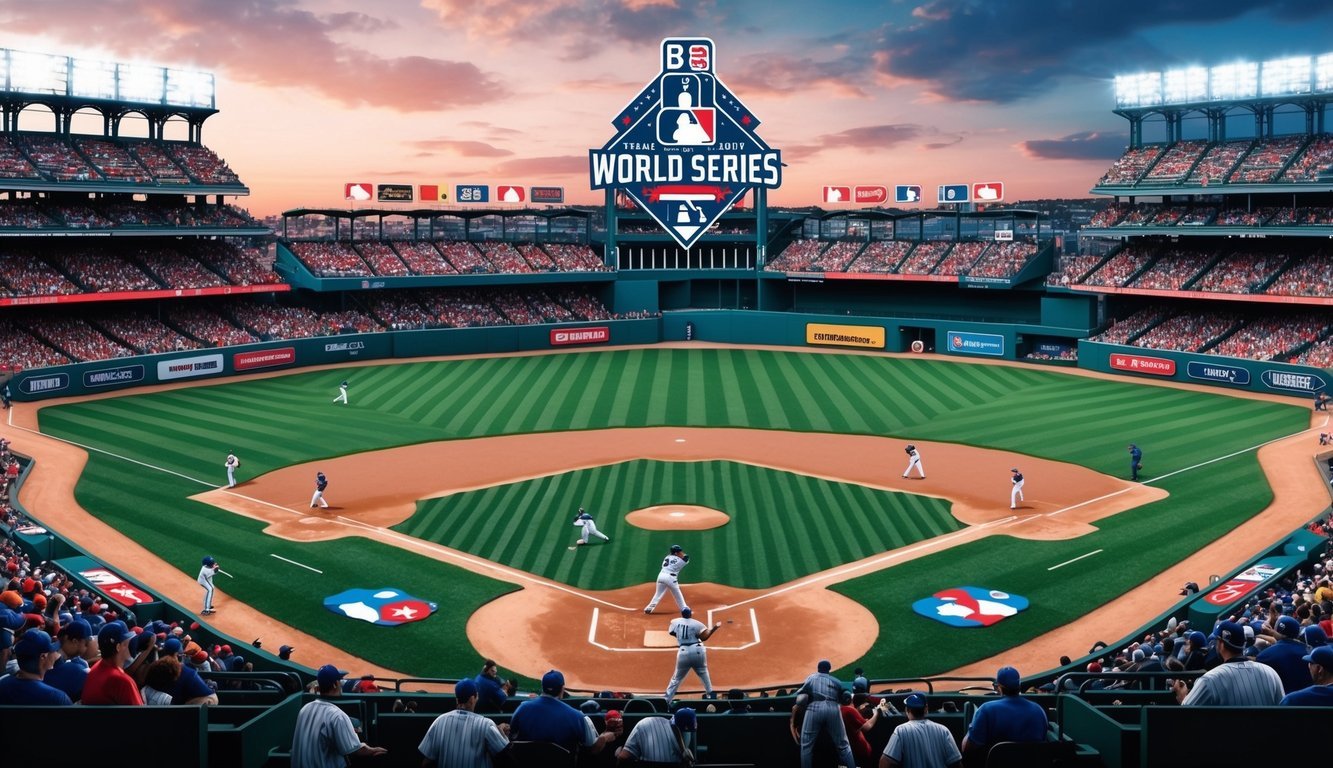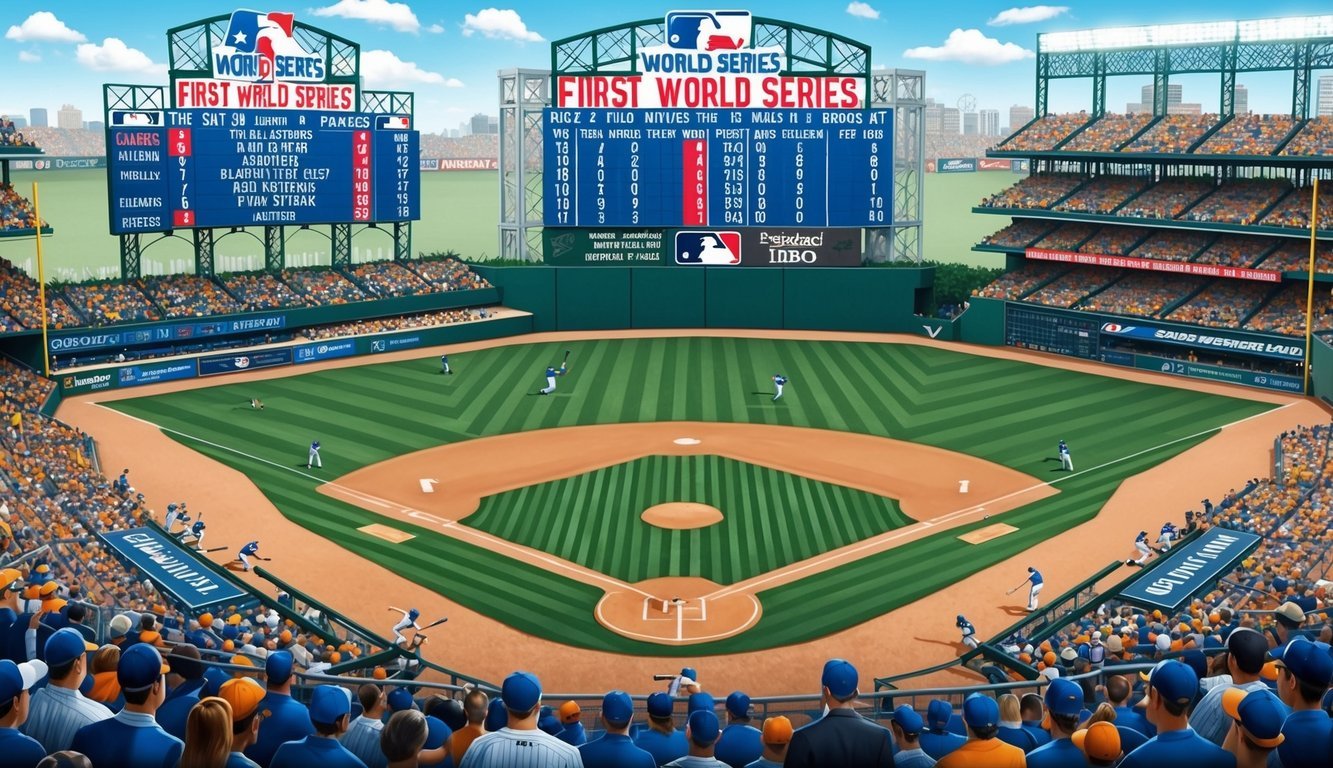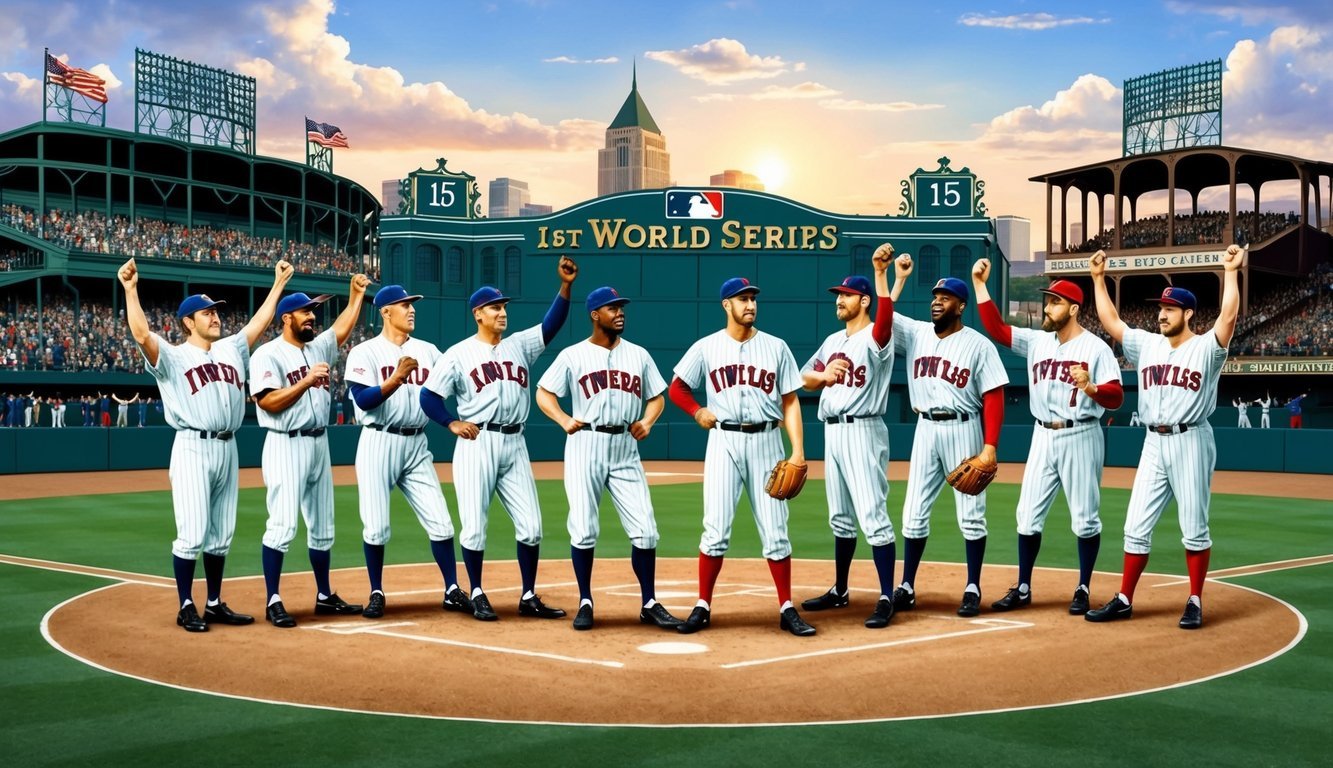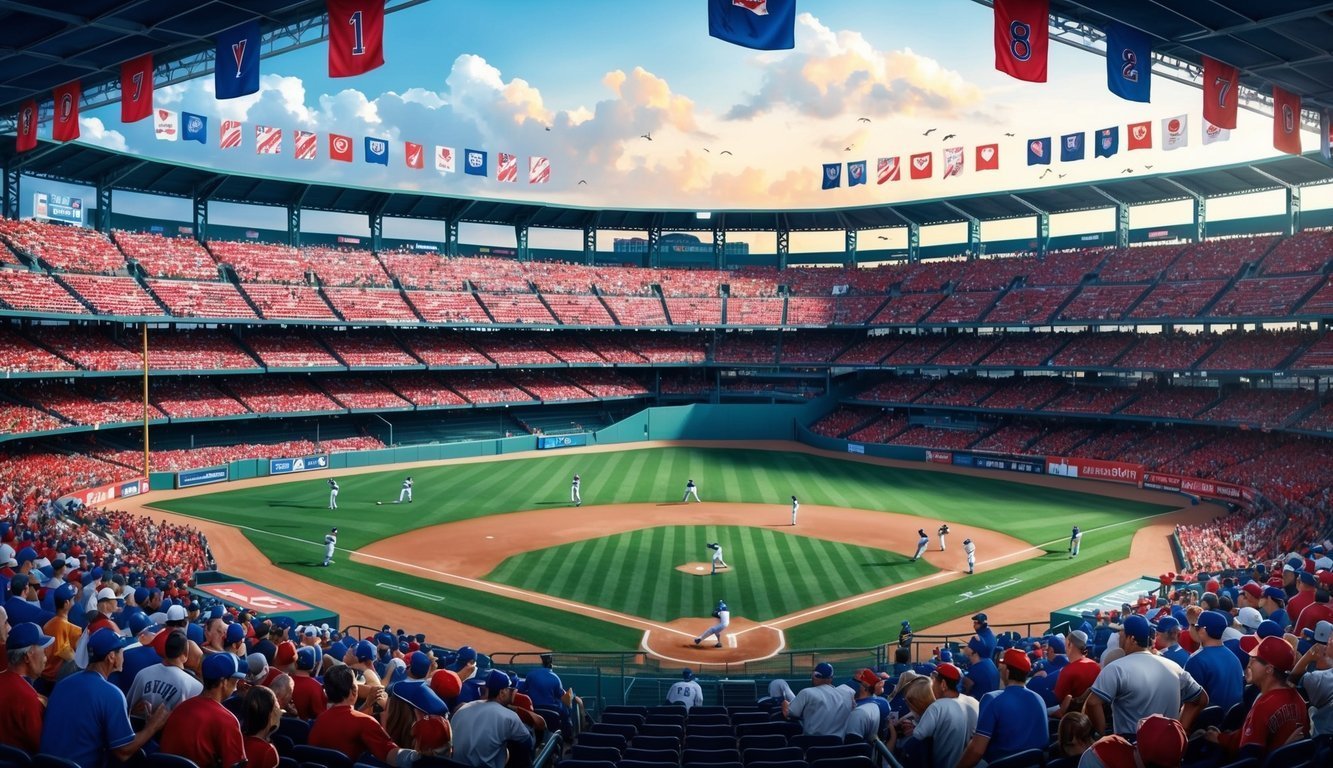The 1903 World Series marked a pivotal moment in baseball history.
This inaugural championship series pitted the American League’s Boston Americans against the National League’s Pittsburgh Pirates.
The Boston Americans emerged victorious, winning five games to three in the best-of-nine format.
Baseball fans were treated to an exciting spectacle as these two powerhouse teams battled for supremacy.
The series showcased the sport’s growing popularity and laid the foundation for what would become an annual tradition in Major League Baseball.
It represented a significant step in unifying the American and National Leagues, which had been fierce rivals until that point.
The 1903 World Series captivated audiences and helped establish baseball as America’s national pastime.
It demonstrated the potential for a grand finale to the baseball season, setting the stage for decades of thrilling championship matchups to come.
The success of this first World Series paved the way for the growth and evolution of professional baseball in the United States.
The Birth of the World Series
The 1903 World Series marked the beginning of a baseball tradition that continues to captivate fans today.
This historic event brought together the top teams from rival leagues, setting the stage for an annual championship spectacle.
The First Championship
The inaugural World Series took place in October 1903, pitting the Boston Americans of the American League against the Pittsburgh Pirates of the National League.
It was a best-of-nine series, with Boston emerging victorious five games to three.
The games alternated between the two cities, creating excitement in both markets.
Fans flocked to the ballparks, eager to witness this groundbreaking competition.
The series showcased the best talent from both leagues, validating the quality of play in the upstart American League.
Key Figures
Cy Young, the legendary pitcher for Boston, played a crucial role in his team’s victory.
He won two games in the series, solidifying his status as one of baseball’s greatest players.
Honus Wagner, Pittsburgh’s star shortstop, struggled at the plate but still demonstrated his exceptional fielding skills.
His presence added star power to the event.
Team owners Henry Killilea of Boston and Barney Dreyfuss of Pittsburgh were instrumental in organizing the series.
Their cooperation helped bridge the gap between the rival leagues.
Ban Johnson’s Role
Ban Johnson, the founder and president of the American League, was a driving force behind the creation of the World Series.
His vision for a strong, competitive league led to the AL’s rapid growth and eventual parity with the established National League.
Johnson’s diplomatic skills were crucial in negotiating a truce with the NL.
This agreement paved the way for the two leagues to compete in a championship series.
His leadership helped establish the World Series as the premier event in baseball, elevating the sport’s popularity and financial success.
Johnson’s efforts laid the foundation for the modern baseball landscape.
1903 World Series Highlights
The inaugural World Series in 1903 featured legendary players and unforgettable moments.
It pitted the Boston Americans against the Pittsburgh Pirates in a best-of-nine series that captivated baseball fans.
The Legendary Players
Cy Young led the Boston Americans with his dominant pitching.
The future Hall of Famer won two games in the series, showcasing his stellar control and endurance.
Jimmy Collins, Boston’s player-manager, contributed both on the field and from the dugout.
His leadership proved crucial in guiding the Americans to victory.
For Pittsburgh, Honus Wagner displayed his exceptional hitting and fielding skills.
The “Flying Dutchman” batted .222 and stole six bases during the series.
Deacon Phillippe emerged as a workhorse for the Pirates.
He started five games, winning three of them, in a remarkable display of stamina.
Iconic Moments
The first World Series home run came off the bat of Pittsburgh’s Jimmy Sebring in Game 1.
This historic blast set the tone for an exciting series.
Patsy Dougherty of Boston had a memorable Game 2.
He hit two home runs, becoming the first player to achieve this feat in World Series play.
The series shifted between two iconic venues.
Boston’s Huntington Avenue Grounds hosted the first three games, while Pittsburgh’s Exposition Park welcomed fans for the next four.
Boston clinched the championship by winning the final four games.
The deciding Game 8 saw Bill Dinneen pitch a shutout, securing a 3-0 victory and the title for the Americans.
The Evolution of the Playoffs

The World Series has undergone significant changes since its inception in 1903.
From format adjustments to expansion of participating teams, baseball’s championship has evolved to meet fan expectations and league needs.
Significant Changes
The first World Series in 1903 was a best-of-nine affair between the Boston Americans and Pittsburgh Pirates.
Boston emerged victorious, clinching the title in eight games.
This format was short-lived, as the Series switched to a best-of-seven in 1905.
The number of teams vying for the championship grew over time.
In 1969, MLB introduced division play, creating a League Championship Series before the World Series.
This expanded the postseason from two to four teams.
1995 saw another major shift with the introduction of the Division Series.
Now eight teams entered the playoffs, battling through three rounds to claim the title.
Modern World Series Format
Today’s World Series is the culmination of a multi-tiered playoff system.
Twelve teams now enter the postseason, with six from each league competing in Wild Card, Division, and Championship Series rounds.
The World Series remains a best-of-seven contest.
Home-field advantage is determined by regular season records, replacing the previous system tied to All-Star Game results.
Innovations like instant replay and the universal designated hitter have further modernized the Fall Classic.
These changes aim to enhance fairness and excitement for fans and players alike.
Statistical Insights and Records

The inaugural World Series in 1903 produced fascinating numbers and set benchmarks that would stand for years to come.
This historic clash between the Boston Americans and Pittsburgh Pirates yielded remarkable individual and team performances.
Remarkable Stats
Cy Young, Boston’s ace pitcher, threw three complete games in the series.
He logged an impressive 34 innings pitched with a 2.12 ERA.
Deacon Phillippe of Pittsburgh matched Young’s workload, starting five games and completing three of them.
The series saw a total of 50 runs scored across 8 games.
Boston outscored Pittsburgh 28-22 overall.
Remarkably, there were 32 errors committed during the series, showcasing the evolving nature of fielding in early baseball.
Honus Wagner, Pittsburgh’s star shortstop, struggled at the plate.
He hit just . 222 with only 6 hits in 27 at-bats.
On the flip side, Boston’s Patsy Dougherty shined, hitting . 331 with 2 home runs.
Despite Wagner’s difficulties, his defensive skills remained unmatched, and he continued to be a valuable asset to the team.
Meanwhile, Dougherty’s impressive performance not only helped elevate the Boston lineup but also positioned him as a contender for the league’s title for most home runs in a season.
As the season progressed, the contrast between the two players became increasingly evident, with Wagner needing to find his batting rhythm to keep the team’s hopes alive.
Lasting Records
Several records set in the 1903 World Series have endured for over a century.
The 8-game format remains the longest World Series ever played.
Deacon Phillippe’s five starts in a single series still stands as a record.
His 44 innings pitched is also a World Series record that’s unlikely to be broken in the modern era.
The series featured an unusual “ground-rule triple” – a rule specific to the Huntington Avenue Grounds in Boston.
Any ball hit into the overflow crowd in the outfield was ruled a triple.
Box scores from the series reveal other interesting tidbits:
- Longest game: 2 hours, 25 minutes (Game 7)
- Shortest game: 1 hour, 30 minutes (Game 2)
- Highest attendance: 18,801 (Game 8)
These stats and records provide a fascinating glimpse into baseball’s first championship series.
Legacy and Impact on Baseball

The 1903 World Series left an indelible mark on America’s pastime.
It solidified baseball’s place in the nation’s heart and set the stage for future championships.
Cultural Significance
The inaugural World Series captured the public’s imagination.
It transformed baseball from a local pastime into a national spectacle.
Newspapers across the country reported on the games, bringing play-by-play action to fans far and wide.
The series helped elevate players to celebrity status.
Names like Honus Wagner and Cy Young became household favorites.
Baseball cards and memorabilia grew in popularity as fans sought connections to their heroes.
Local businesses in Boston and Pittsburgh thrived during the series.
Restaurants, hotels, and transportation services saw increased demand.
This economic boost became a hallmark of future World Series events.
Defining Moments
The 1903 series featured several memorable plays that live on in baseball lore.
Deacon Phillippe showcased his pitching prowess with three complete-game victories for Pittsburgh.
Boston’s comeback from a 3-1 deficit demonstrated the drama and unpredictability of the sport.
The success of the event led to its annual tradition.
It cemented the American League’s legitimacy and paved the way for true “World Champions” in baseball.
As a result, the World Series trophy became the most coveted prize in the sport.
Retrosheet and Baseball Almanac now preserve detailed records of this historic series.
These archives allow fans to relive the excitement and study the game’s evolution.
The 1903 World Series continues to inspire modern players and shape baseball’s future.
